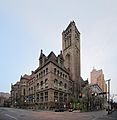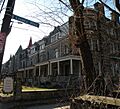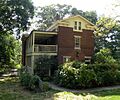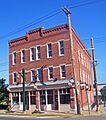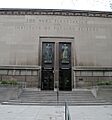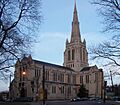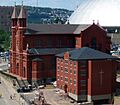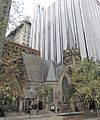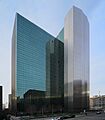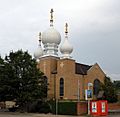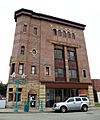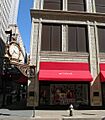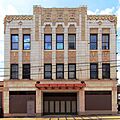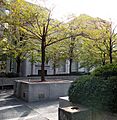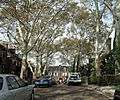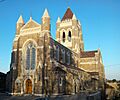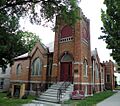The Pittsburgh History and Landmarks Foundation (PHLF) started a special program in 1968. Its goal was to find and celebrate important buildings and places in Allegheny County, Pennsylvania. These places are chosen because they are beautiful, unique, or have a big story to tell about Pittsburgh's past.
When a place is nominated, a group of experts, including historians and community members, carefully reviews it. If it's chosen, the building usually gets a special metal plaque on the outside. This plaque shows everyone that the building is a recognized historic landmark!
What is the PHLF Plaque Program?
The PHLF plaque program is like a special award for buildings and places. It helps people learn about the history and amazing architecture of the Pittsburgh area. Since it started, over 500 places have received these plaques.
How Places Are Chosen
To become a PHLF Historic Landmark, a building or place needs to be nominated. This means someone suggests it because they think it's important. Then, a committee of experts looks at the nomination. They check if the place has a special design, a rich history, or is important to the local community.
In 2010, the program grew! It started looking at places up to 250 miles away from Pittsburgh. But there's a catch: these places still need to have a connection to the greater Pittsburgh region.
What the Plaque Means
Getting a PHLF plaque is a big honor! It means the building or place is recognized for its historical or architectural value. However, it's important to know that this plaque doesn't stop anyone from changing or even tearing down the building. It's more about celebrating its importance and helping people appreciate it.
These plaques are different from other historic designations, like those given by the City of Pittsburgh. The PHLF program focuses on highlighting the unique stories and designs of places across the region.
Examples of Landmarks
Many different kinds of places have received PHLF plaques. They include homes, churches, schools, bridges, and even parks! Each one tells a part of the Pittsburgh story.
For example, the beautiful Allegheny County Courthouse in Downtown Pittsburgh received a plaque in 1968. It was designed by a famous architect named Henry Hobson Richardson. Another example is the Carnegie Library of Pittsburgh in Oakland, which got its plaque in 1970. This library was a gift from Andrew Carnegie and is a very important place for learning.
Bridges are also recognized, like the Smithfield Street Bridge, which received a plaque in 1970. It's one of the oldest and most interesting bridges in the city. Even parts of parks, like Schenley Park, have been recognized for their historical importance.
Images for kids
-
The George Leber House, built in 1938.
-
A historic home at 841 North Lincoln Avenue, built in 1878.
-
The building at 899 Old Thorn Run Road, dating back to 1814.
-
The Byrnes & Kiefer Building on Penn Avenue, constructed in 1892.
-
The 1939 House, also known as the Good Housekeeping house.
-
The Alexander M. Guthrie house on Ellsworth Avenue, built around 1870.
-
Buildings on the 5800 block of Pierce Street, built 1891-92.
-
The house at 6661 Aylesboro Avenue, built in 1886 and remodeled in the 1920s.
-
The George J. Schmitt House on Ohio River Boulevard, built in 1916.
-
The Addy-Spencer House, built between 1864-69.
-
The Frank Alden house, built in 1890.
-
The Alder Court apartments, built in 1913.
-
All Saints' Roman Catholic Church, built in 1914.
-
Taylor Allderdice High School, built in 1927.
-
The Allegheny Arsenal Powder Magazine, built in 1814.
-
Allegheny Cemetery, founded in 1844.
-
The Butler Street Entrance to Allegheny Cemetery, built 1847, 1870.
-
The Penn Avenue Entrance to Allegheny Cemetery, built in 1887.
-
The Allegheny City Electric Light Plant—1895 building.
-
The Allegheny Country Club, built in 1902.
-
Allegheny County Airport, built in 1931 and 1936.
-
The Allegheny County Court House, built in 1888.
-
The Allegheny County Fairgrounds, built 1927–1934.
-
The Allegheny County Jail (now Family Court Facility), built in 1886.
-
Allegheny General Hospital (1930 part), built 1928–1930.
-
The Allegheny HYP Club, built in 1890 and remodeled 1930-31.
-
The site of the Allegheny Market House, built in 1863.
-
The Allegheny Observatory, built in 1900.
-
The Allegheny Regional Branch, Carnegie Library of Pittsburgh, built in 1890.
-
The Allegheny Social Hall, built 1902-03.
-
Allegheny Traditional Academy (formerly Allegheny High School), built 1904, 1937.
-
The Allegheny West Historic District, developed 1850–1874, 1875–1899.
-
Allen Hall, University of Pittsburgh (Old Mellon Institute), built in 1915.
-
Alpha Terrace Historic District, built around 1889, 1894.
-
Alumni Hall, University of Pittsburgh (Masonic Temple), built in 1914.
-
Anderson Manor (James Anderson house), built around 1830, 1905.
-
The Andrew Carnegie Free Library, built in 1899.
-
The John Arch house, built in 1874.
-
The Armstrong Tunnel, built 1926-27.
-
The Arrott Building, built in 1902.
-
Arsenal Middle School, built in 1932.
-
The Art Institute of Pittsburgh (formerly the Equitable Gas Company Building), built 1924-25.
-
The Arthurs-Johnson House, built in 1873.
-
Aspinwall, incorporated in 1893.
-
The Atwell-Christy house, built in 1862.
-
"Bagatelle" (James G. Pontefract house), built in 1894.
-
Baker Hall (Central Building, Administration Hall), built 1914, 1919.
-
Baxter-Brushton School, built in 1909.
-
"Baywood" (Alexander King Estate), built around 1880; 1890.
-
"Bear's Retreat", built 1790, 1840.
-
Bedford Springs Hotel and Golf Course, built around 1806 and after.
-
Beechwood Elementary School, built 1908, 1923.
-
Bellefield Hall (YMHA), built in 1924.
-
Bellevue Public Library, built in 1875.
-
Beltzhoover Elementary School, built in 1909.
-
The Benedum Center for the Performing Arts (Stanley Theatre), built in 1927.
-
The Benedum-Trees Building, built in 1905.
-
Beulah Presbyterian Church, built in 1837.
-
The Bigham House, built in 1844.
-
Boggs Avenue Elementary School, built in 1925.
-
Boss Hall, built in 1916.
-
The Bost Building, built 1891-92.
-
The Boyer house, built around 1840.
-
The Brix at 26 (Pittsburgh Mercantile Company), built in 1908.
-
Braddock Carnegie Library, built 1888, 1893.
-
The George Brayman house, built in 1953.
-
Manchester Bridge Pier, built various years.
-
Bridgeville Public Library, built around 1870.
-
The Brilliant Cutoff Viaduct of the Pennsylvania Railroad, built in 1902.
-
Brown Chapel A.M.E. Church, built in 1903.
-
Brown Road Bridge (in Tinbrook Park), built in 1891.
-
The Buhl Building, built in 1913.
-
The Buhl Planetarium and Institute of Popular Science, built in 1939.
-
Burke's Building, built in 1836.
-
The Burtner House, built in 1821.
-
Byers Hall, Community College of Allegheny County, built in 1898.
-
The Byham Theater (Fulton or Gayety Theatre), built in 1904.
-
Calvary A.M.E. Church of Braddock, built in 1892.
-
Calvary Episcopal Church, built in 1907.
-
Calvary United Methodist Church, built in 1895.
-
Carlow College Worship and Community Center (St. Agnes' Roman Catholic Church), built in 1917.
-
Carnegie Coffee Company (Carnegie U.S. Post Office), built in 1916.
-
Carnegie Free Library of McKeesport, built in 1902.
-
Carnegie Mellon University, the original campus, built 1905-32.
-
Carnegie Institute, built 1895, 1907.
-
Carnegie Library of Homestead, built in 1898.
-
Carnegie Library of Pittsburgh, built in 1895.
-
Carnegie Library of Pittsburgh, Homewood Branch, built in 1910.
-
Carnegie Library of Pittsburgh, Lawrenceville Branch, built in 1898.
-
Carnegie Library of Pittsburgh, Mount Washington Branch, built in 1900.
-
Carnegie Library of Pittsburgh, South Side Branch, built in 1909.
-
Carnegie Library of Pittsburgh, West End Branch, built in 1899.
-
Carnegie Steel Manager's house, built in 1900.
-
Carrie Furnaces and Pinkerton Landing site, built 1884, 1892.
-
The Rachel Carson house, built in 1870.
-
The Cathedral of Learning, built 1926–1937.
-
Cathedral of Learning interiors, built 1937–1946.
-
The Croghan-Schenley Ballroom, built in 1835.
-
Central Catholic High School, built in 1927.
-
Chalfant Hall, Community College of Allegheny County, built around 1900.
-
The Chalfant house, built around 1850.
-
Chalfant Log House, built in 1832.
-
The Chancellor's house (Harvey Childs house), built in 1896.
-
Chatham Village, built 1932, 1935.
-
Christian Tabernacle Kodesh Church of Immanuel (St. Paul's Episcopal Church), built in 1896.
-
St. John the Baptist Church (The Church Brew Works), built in 1903.
-
The Church of St. Benedict the Moor, built in 1894.
-
The Church of the Ascension, built in 1898.
-
The Church of the Epiphany, built in 1902.
-
The Church of the Good Shepherd, built in 1891.
-
The Church of The Holy Cross (St. James Episcopal Church), built 1905-06.
-
City of Pittsburgh Department of Water, begun around 1907.
-
City Theatre, built in 1859.
-
The City-County Building, built 1915–1917.
-
The Clark Candy Company chimney, built in 1924.
-
"Clayton", built around 1870, 1892.
-
The College of Fine Arts (School of Applied Design), built 1912, 1916.
-
Colfax Elementary School, built in 1911.
-
Colonial Place Historic District, built in 1898.
-
The Coltart house, built in 1843.
-
Commerce Court, built in 1918.
-
Concord Elementary School, built in 1939.
-
Congregation B'nai Israel, built in 1923.
-
Connelly School, built in 1930.
-
Conroy Education Center, built in 1936.
-
The Convent of Mercy, built in 1909.
-
The Corliss Tunnel, built in 1914.
-
The Cork Factory (Armstrong Cork Company Buildings), built 1901, 1902; addition 1913.
-
The County Office Building, built 1929-31.
-
Coursin Heights Plan/Becker house, built in the 20th century.
-
The Craig-Wertheimer house, built around 1870.
-
Crawford House/Ingleside Hotel, built in 1866.
-
Creighton Avenue, built around 1900.
-
The Crescent Apartment Building, built around 1904.
-
Cross Keys Inn, built around 1851.
-
D'Arlington Apartments, built in 1910.
-
The Harry Darlington House, built around 1890.
-
The Davis farmhouse, built around 1880.
-
Superintendent Henry J. Davis House, U.S. Steel Clairton Works, built 1903–1910.
-
Devonshire Street, built late 19th century.
-
Dilworth School, built in 1915.
-
Dixmont State Hospital, built in 1862.
-
Dollar Savings Bank, built in 1871.
-
Doherty Hall, built in 1908.
-
Dormont Swimming Pool, built in 1920.
-
The Harlan Douglas house, built 1962-1965.
-
The Duquesne Club, built in 1887.
-
The Duquesne Incline, built in 1877.
-
East Liberty Presbyterian Church, built in 1935.
-
East Pittsburgh U.S. Post Office, built in 1916.
-
Ebenezer Baptist Church, built in 1931.
-
Edgar Thomson Works, United States Steel, since 1875.
-
Edgewood, incorporated in 1888.
-
Edgeworth Club, built 1930-31.
-
Eggers House, built prior to 1860.
-
Elizabeth Borough Historic District, built 1850–1930.
-
Ellsworth Terrace, built in 1913.
-
"Elm Ridge", James Gardiner Coffin/John Walker House, built in 1869.
-
Elmhurst Road Historic District, built 1904-20.
-
Elroy Elementary School, built 1920 and 1925.
-
Emmanuel Episcopal Church, built in 1886.
-
Emsworth Locks and Dam, built 1922 and 1928.
-
Episcopal Church of the Nativity, built 1908; 1935.
-
Episcopal Church of the Redeemer, built in 1937.
-
Express House, built around 1900.
-
The Fay Bear house, built around 1950.
-
The Federal Reserve Bank of Cleveland, Pittsburgh Branch, built 1930-33.
-
Fifth Avenue High School, built in 1894.
-
The F. Esther Fineman house, built in 1952.
-
First Associate Reformed Church, built in 1854.
-
First Baptist Church, built in 1912.
-
First Church of Christ Scientist, built in 1905.
-
First English Evangelical Lutheran Church, built in 1888.
-
First Hungarian Reformed Church, built in 1904.
-
First Muslim Mosque of Pittsburgh, built in 1899.
-
First National Bank of Pitcairn, built around 1910.
-
First Presbyterian Church, built in 1903.
-
First Presbyterian Church of Edgewood, built in 1918.
-
First United Methodist Church, built in 1893.
-
First United Methodist Church, built in 1889.
-
First United Methodist Church of McKeesport, built in 1925.
-
First United Methodist Church of Wilmerding, built 1913-15.
-
First United Presbyterian Church, built in 1893.
-
Flatiron Building, built around 1875.
-
Forbes Field wall: remnant, built in 1909.
-
The Forsythe Home, built in 1850.
-
The Fort Pitt Blockhouse, built in 1764.
-
Fort Pitt Boulevard, built between 1850 and 1890.
-
Fort Pitt Elementary School, built 1905; 1910.
-
Fortieth Street (Washington Crossing) Bridge, built in 1924.
-
Stephen Collins Foster Memorial, built in 1937.
-
Four Gateway Center and The Plaza at Gateway Center, built 1960 (building), 1962 (plaza).
-
The Four Sisters' House, built in 1872.
-
Fourth Avenue National Register District, built around 1900.
-
Fox Chapel Golf Club, built 1924-25.
-
Freight House, built in 1897.
-
The John Frew House, built around 1790; addition around 1840.
-
The Frick Building, built in 1902.
-
Frick International Studies Academy, built in 1927.
-
Friendship Elementary School, built in 1899.
-
Fulton Academy of Science, built 1894, 1900, and 1929.
-
Gardner Steel Conference Center, University of Pittsburgh, built 1911-12.
-
The Gardner-Bailey House, built in 1864.
-
The Garfield-Scott house, built in 1964.
-
The Gatehouse, built in 1916.
-
Mr. & Mrs. David Giles house, built in 1952.
-
Gilfillan Farm House, built in 1857.
-
Gimbel Brothers Department Store (Heinz 57 Center), built in 1914.
-
Glenshaw Railroad Station, built in 1915.
-
Glenshaw Valley Presbyterian Church, built in 1885.
-
Grace Episcopal Church, built in 1926.
-
Grace United Methodist Church, built in 1872.
-
Graff Building, built in 1912.
-
The Graham house, built around 1840.
-
Granite Building (German National Bank), built in 1890.
-
The Great Stone Wall, Allegheny Reservoir, built in 1848.
-
Greenfield Elementary School, built 1916-23.
-
Greenstone United Methodist Church, built in 1906.
-
The Lord Griffith house, built in 1902.
-
The Grotto, built 1928-32.
-
The Gulf Building, built in 1932.
-
The Gwinner-Harter House, built around 1870, 1911.
-
Skibo Gymnasium, built 1923, 1932.
-
The Half Dingle (Stanley Marshall), built in 1964.
-
The Haller-Bursztynowicz house, built around 1890.
-
Hamburg Hall (U.S. Bureau of Mines), built in 1915.
-
Hamerschlag Hall (Machinery Hall), built 1906, 1914.
-
Hampton Hall, built around 1926.
-
The Hampton-Kelly house, built in 1852.
-
The Harbaugh-Grafflin house, built in 1866.
-
The Hartley-Rose Building, built in 1907.
-
Hartwood Farms, built in 1929.
-
The Hawker house, built mid 19th century.
-
The Hays house, built around 1870.
-
Heathside Cottage, built in 1855.
-
Heinz Hall for the Performing Arts, built 1926, 1971.
-
Heinz Lofts (five H. J. Heinz Company buildings), built 1913-27.
-
Heinz Memorial Chapel, built in 1938.
-
The Hellmund house, built in 1916.
-
Henderson Hall, built in 1916.
-
The Henderson-Metz House, built around 1860.
-
The Hendricks-Murray house, built around 1874.
-
Samuel Heppenstall (estate), built around 1885.
-
Herron Hill Park, built in 1889.
-
Highland Park (the Park), begun in 1889.
-
The Howard J. Hill house, built around 1835.
-
Highland Towers, built in 1913.
-
The Highwood, built 1929-30.
-
Hiland Presbyterian Church, built 1940 and earlier.
-
The Hill-McCallam-Davies house, built in 1852.
-
The Holleman house, built in 1920.
-
Jane Holmes Residence and Gardens, built in 1869.
-
Holy Rosary Roman Catholic Church, built in 1928.
-
Holy Virgin Russian Orthodox Greek Catholic Church, built in 1920.
-
The Homestead High Level Bridge, built 1935-37.
-
Homewood Cemetery, incorporated in 1878.
-
Honor Built houses (an example of), built in 1924.
-
The Joseph Horne Company Department Store, built 1900, 1923.
-
The Joseph Horne House, built in 1889.
-
Hot Metal Street Bridge and former Hot Metal Bridge, built 1900 and 1904.
-
The Howe-Childs Gatehouse, built around 1860.
-
Hunt Armory, built 1911, 1916, 1919.
-
The Husler Building, built in 1896.
-
Hyeholde, built 1931-38, 1952.
-
Immaculate Heart of Mary Church, built in 1904.
-
Ingram Elementary School, built in 1914.
-
Iron fence from "The Maples", built around 1890.
-
The Arthur Jeffrey house, built in 1947.
-
Jenkins Arcade, built in 1913.
-
Jerusalem Baptist Church, built in 1864.
-
Jones Hall, Community College of Allegheny County, built around 1908.
-
The Jones house, built in 1915.
-
The Joseph Katz house (McComb house), built in 1950.
-
Kaufmann Auditorium, built in 1928.
-
Kaufmann's Department Store and Clock, built 1898, 1913.
-
Kennywood Park: Casino, built in 1899.
-
Kennywood Park: Grand Carousel, built around 1926.
-
Kennywood Park: the Racer, built in 1927.
-
The Thomas Keown house, built 1842-50.
-
The Allen M. Klages house, built in 1923.
-
Knoxville Elementary School, built 1927.
-
Kopp Glass, Inc., built in 1899.
-
The Koppers Building, built in 1929.
-
The Kramer house, built around 1854.
-
The Kuykendall-Forsyth-Reed farm, built 1768, 1852.
-
"La Tourelle" (Edgar J. Kaufmann house), built in 1924.
-
Mr. & Mrs. Jack Landis house, built in 1957.
-
Langley High School, built around 1900, 1929.
-
-
Lawrence Hall, Point Park University, built 1927-29.
-
Lebanon Presbyterian Church, built in 1871.
-
Lemington Elementary School, built in 1937.
-
Letsche Education Center, built 1905; 1941.
-
Letter Carriers' Local 84 Union Hall, built in 1928.
-
Liberty Tunnels Ventilating Plant, built in 1928.
-
The Isaac Lightner House, built in 1833.
-
Lincoln Avenue Viaduct, built in 1905.
-
Lincoln Elementary School, built in 1931.
-
Linden Elementary School, built 1903; 1927; 1960.
-
Linwood Apartments, built in 1907.
-
The Saul Lipkind house, built in 1954.
-
Longue Vue Club, built in 1925.
-
"Lyndhurst" estate wall, built around 1885.
-
Lysle Boulevard Bridge, built in 1937.
-
Madison Elementary School, built 1902, 1929.
-
The H. P. Malick house, built around 1900.
-
Manchester, platted in 1838.
-
Mansions on Fifth, built 1905-07.
-
Margaret Morrison Carnegie Hall, built 1906, 1914.
-
Market at Fifth, built 1870s, 1908-09, 1927.
-
Market Square Place (portion), built in 1930.
-
Masonic Building, built in 1909.
-
Mauro water tower, built around 1900.
-
McCleary Elementary School, built in 1900.
-
McGill Hall, built in 1916.
-
The McGinley house, built in 1804.
-
McGuffey Building, built in 1882.
-
McKees Rocks Bridge, built 1930-32.
-
McKeesport National Bank, built in 1891.
-
McKeesport Waterworks, built 1908, 1925.
-
"Meado'cots", built in 1912.
-
Mellon Bank, built in 1924.
-
The Andrew W. Mellon house, built in 1897.
-
Mellon Institute of Industrial Research, built 1931-37.
-
Mellon Park, built in 1943.
-
Mellon Square, built 1954-55.
-
C. C. Mellor Library and Edgewood Club, built in 1914.
-
Mexican War Streets National Register District, built 1850–1900.
-
Mifflin Elementary School, built in 1932.
-
Miller African-Centered Academy, built 1905; 1939.
-
The Miller–Cole house, built in 1952.
-
The Oliver Miller Homestead, built 1808, 1830.
-
The Miller House, built in 1905.
-
The Andrew S. Miller House, built in 1902.
-
The Miller-Zorn-Bush house, built 1840–1850.
-
The Monongahela Incline, opened in 1870.
-
The Montgomery house, built in 1877.
-
Moore Elementary School, built 1914, 1941, 1997.
-
The Moreland-Hoffstot House, built in 1914.
-
Morrow Barn, built in 1834.
-
Morrow Elementary School, built in 1895.
-
Most Holy Name of Jesus Rectory, built around 1875.
-
Motor Square Garden, built in 1900.
-
Mount Assisi, built in 1927.
-
Mt. Lebanon Golf Course, built 1907-08.
-
Mt. Lebanon Municipal Building, built 1928-30.
-
Munhall Volunteer Fire Company #1, built in 1902.
-
Municipal Building, built in 1938.
-
"Muottas" (William Walker house), built in 1904.
-
Murray Hill Avenue Historic District, built after 1890.
-
The Murray house, built around 1830.
-
The Muse house, built in 1820.
-
National Carpatho-Rusyn Cultural and Educational Center, built in 1903.
-
Natrona Bank, built in 1900.
-
The Neill Log House, built 1765–1770.
-
The Neville house ("Woodville"), built 1785 and after.
-
The New Granada Theater, built 1927-28.
-
New Zion Baptist Church, built in 1867.
-
"Newington", built 1816, 1823.
-
North Park Golf Club House, built in 1937.
-
The Hulda and Louise Notz house, built in 1940.
-
Oakmont Carnegie Library, built in 1901.
-
Oakmont Country Club, built in 1904.
-
The Ober-Guehl house, built in 1877 and later.
-
Old Crossroads Presbyterian Church, built in 1896.
-
Old Heidelberg Apartments, built 1905, 1908.
-
Old St. Luke's (St. Luke's Episcopal Church), built in 1852.
-
Old Sewickley Train Station, built in 1887.
-
Old Stone Bridge, built around 1870.
-
Old Toll House (Rising Sun Inn), built in 1827.
-
The Henry W. Oliver Building, built in 1910.
-
Oliver High School, built in 1925.
-
Osterling Studio and Office, built in 1917.
-
Oyster House (Bear Tavern Site), built 1827, 1870.
-
Panther Hollow Bridge, built in 1897.
-
Parkstone Dwellings, built in 1922.
-
Parkway steps, built in 1936.
-
"Peleponesus", built around 1835.
-
Penn Brewery and Brewery Innovation Center, built around 1880 and after, 1884.
-
Pennsylvania Railroad Fruit Auction & Sales Building, built in 1929.
-
Pennsylvania Railroad Station, built in 1903.
-
Pennsylvania Railroad Station, built in 1916.
-
Pennsylvania Railroad Station Rotunda, built 1898–1903.
-
The Pennsylvanian (Union Station), built 1898–1903.
-
Perry Traditional Academy, built in 1899.
-
Phipps Conservatory, built in 1893.
-
The Pierce house, built prior to 1850.
-
Pitt Building (Americus Club), built in 1918.
-
Pittsburgh Athletic Association, built in 1911.
-
Pittsburgh Ballet Theater Building, built around 1900.
-
Pittsburgh Brewing Company, built 1888 and after.
-
Pittsburgh Center for the Arts, built 1912, 1980s.
-
The Pittsburgh Children's Center, built in 1930.
-
Pittsburgh Children's Museum, built in 1897.
-
Pittsburgh Engineer's Building, built in 1898.
-
Pittsburgh Gifted Center, built in 1911.
-
The Pittsburgh Golf Club, built in 1899.
-
Pittsburgh & Lake Erie Coraopolis Station, built in 1895.
-
Pittsburgh & Lake Erie Railroad Station, built in 1901.
-
Pittsburgh Musical Theater, built in 1916.
-
Pittsburgh's Grand Hall at the Priory, built 1854; addition 1906.
-
PNC Train Station at Greensburg, built in 1911.
-
Porter Hall, built 1905, 1915.
-
The James Powers Homestead, built in 1797.
-
Prospect Elementary School, built 1931; 1936.
-
Provincial House of Sisters of Divine Providence, built in 1927.
-
The Rankin house, built in 1831.
-
"Red Gables" (Frank Alden house), built in 1894.
-
Regional Enterprise Tower, built 1950-53.
-
Renaissance Pittsburgh Hotel, built in 1906.
-
The Lydia A. Riesmeyer house, built in 1914.
-
Riverview United Presbyterian Church, built in 1907.
-
"Robin Hill", built in 1926.
-
Rodef Shalom Congregation, built in 1906.
-
Rogers School for the Creative and Performing Arts, built in 1914.
-
Roslyn Place (entire fabric), begun in 1913.
-
Roslyn Place pavement, built 1913 and after.
-
The Ross-Tooke house, built around 1835.
-
Round Hill United Presbyterian Church, built in 1804.
-
The Marius Rousseau House, built in 1906.
-
Royal York Apartments, built in 1937.
-
Sacred Heart Roman Catholic Church, built 1924-53.
-
St. Adalbert Church, built in 1889.
-
St. Andrew's Episcopal Church complex, built in 1909.
-
St. Anselm's Roman Catholic Church, built in 1924.
-
Saint Augustine's Church, built in 1899.
-
St. Basil's Roman Catholic Church, built in 1923.
-
St. Bernard's Roman Catholic Church, built 1933-47.
-
St. Boniface Church, built in 1926.
-
St. Colman's School, built in 1928.
-
St. James Terrace, built in 1915.
-
St. John the Baptist Ukrainian Catholic Church, built 1895, 1917.
-
St. Josaphat's Roman Catholic Church, built 1909-16.
-
St. Joseph's Roman Catholic Church, built in 1886.
-
St. Luke's Evangelical Lutheran Church, built in 1927.
-
St. Margaret's Hospital Chapel, built in 1894.
-
St. Mary Magdalene Church, built 1895; 1936.
-
St. Mary of the Mount Church, built in 1896.
-
St. Mary's Church, built in 1874.
-
St. Mary's Priory, built in 1888.
-
St. Mary's Ukrainian Orthodox Church, built in 1922.
-
St. Matthew's A.M.E. Zion Church, built around 1910.
-
St. Michael Archangel Church, built in 1927.
-
St. Michael the Archangel Church, built in 1851.
-
St. Michael the Archangel Church (Angel's Arms Condominiums), built in 1861.
-
St. Michael's Russian Orthodox Greek Catholic Church, built 1903–1910.
-
St. Nicholas Cathedral (First Congregational Church), built in 1904.
-
St. Nicholas Croatian Church, built in 1900.
-
St. Nicholas Roman Catholic Church, built in 1900.
-
St. Paul Baptist Church, built in 1887.
-
St. Paul of the Cross Monastery, built 1854 and later.
-
St. Paul's Roman Catholic Cathedral, built in 1906.
-
St. Peter's Episcopal Church, built in 1852.
-
St. Peter's Evangelical and Reformed Church, built in 1889.
-
St. Peter's Roman Catholic Church, built in 1874.
-
St. Philip Roman Catholic Church, built in 1906.
-
St. Stanislaus Kostka Church, built in 1891.
-
St. Stephen's Episcopal Church, built in 1903.
-
St. Thomas Roman Catholic Church, built in 1904.
-
Saints Peter and Paul Roman Catholic Church, built in 1891.
-
St. Peter & St. Paul Ukrainian Orthodox Greek Catholic Church, built in 1906.
-
Salk Hall (Municipal Hospital), built in 1940.
-
Schenley Apartments, built in 1922.
-
Schenley Bridge, built in 1897.
-
Schenley Farms District, planned in 1905.
-
Schenley High School, built 1915-16.
-
Schenley Hotel, built in 1898.
-
Schenley Park, begun in 1889.
-
Schenley Park Visitors Center, built in 1910.
-
Schiller Classical Academy, built in 1939.
-
The Schiller house, built 1807, 1846.
-
Schoolhouse Arts Center, built in 1905.
-
The Charles Schwab house, built in 1893.
-
Scobell Hall, built in 1918.
-
Second Presbyterian Church of Wilkinsburg, built 1905; 1910; 1928.
-
Seldom Seen Arch, built in 1903.
-
The Sellers-Carnahan House, built in 1858.
-
The Sellers-Grove house, built around 1851.
-
Settler's Cabin, built 1780s?, 1855.
-
Sewickley Post Office, built in 1910.
-
Sewickley Presbyterian Church, built in 1861.
-
Sewickley Public Library, built 1923; annex 2000.
-
Shadyside Presbyterian Church, built 1889, 1892.
-
The James Wilson Shaw house, built in 1827.
-
The Thomas Shaw house, built 1824, 1832.
-
The Shaw-Tatom house, built 1824, 1832.
-
Shelly/Stella Street terracing, built in the 1930s.
-
Shields Presbyterian Church, built in 1869.
-
The Shinn-Beall house, built around 1851.
-
The Peter Shouse house, built around 1840.
-
The Shrine of St. Anthony of Padua, built 1880, 1891.
-
The Siebert house, built in 1892.
-
The John F. Singer house, built in 1865.
-
The Sixteenth Street Bridge, built in 1923.
-
Sixth, Seventh, and Ninth Street Bridges, built 1926-28.
-
Smithfield Congregational (United) Church, built in 1926.
-
The Smithfield Street Bridge, built in 1883.
-
The William Penn Snyder House, built in 1911.
-
The Snyder-Bockstoce house, built 1835-50.
-
Soldiers' and Sailors' Memorial Hall, built in 1911.
-
South Craig Street District, built late 19th and mid 20th century.
-
South Hills Retirement Residence, built in 1924.
-
South Park Golf Club House, built in 1938.
-
South Side Market House, built 1891, 1915.
-
South Vo-Tech High School, built 1897, 1923.
-
Southminster Presbyterian Church, built 1927-28.
-
The Tillie S. Speyer house, built in 1963.
-
The Abraam Steinberg house, built in 1951.
-
Sterrett Classical Academy, built in 1898.
-
Stevens Elementary School, built in 1940.
-
The Louis S. Stevens house, built in 1925.
-
Stevenson Building, built in 1896.
-
Stewart Avenue Lutheran Church, built in 1927.
-
The W. J. Stewart/Howard Stewart house, built in 1873.
-
The Stewart-Schlag house, built in 1834.
-
Strawberry Way, built around 1890.
-
"Sunnyledge" (McClelland house), built in 1886.
-
Swan Acres Historic District, built in 1936.
-
The E. H. Swindell Bridge, built in 1930.
-
Tarentum Historic District, built 1886–1920.
-
Temple Sinai (Worthington house), built 1910, 1915.
-
Teutonia Maennerchor, built in 1888.
-
Thaw Hall, University of Pittsburgh, built in 1909.
-
Third Presbyterian Church, built in 1903.
-
The Frank Thornburg house, built around 1907.
-
"Titlenure", built around 1770.
-
The Torrence house, built 1790s, 1883.
-
The Olin Trapp house, built in 1963.
-
Trinity Episcopal Cathedral, built in 1872.
-
Trinity German Evangelical Lutheran Church, built in 1868.
-
Triumph the Church and Kingdom of God in Christ, built in 1901.
-
Troy Hill Fire Station #39, built in 1901.
-
The Troy Hill Incline site, built in 1887.
-
The Union Trust Building, built in 1917.
-
The United Steelworkers Building, built in 1963.
-
Urban Room, William Penn Hotel, built in 1929.
-
U.S. Post Office, built in 1912.
-
Veronica's Veil Auditorium, built in 1900.
-
Victoria Hall, built 1868 and after.
-
Victory Baptist Church, built in 1865.
-
The Joseph Vokral house, built in 1936.
-
The Walker house, built in 1844.
-
The Walker-Ewing Log House, built around 1790.
-
The Walker-Way house, built 1810; 1820; 1841.
-
The Andy Warhol Museum, built around 1913.
-
Washington Polytechnic Academy, built 1908; 1920?; 1937.
-
Waverly Presbyterian Church, built in 1930.
-
The Abishai (or Nicholas) Way House, built in 1838.
-
Weil Technology Institute, built in 1942.
-
The Edward Weinberger house, built in 1948.
-
Welch Hall, built in 1918.
-
The West End Bridge, built 1930-32.
-
West End Park, built in 1908.
-
West End United Methodist Church, built in 1887.
-
West Hall, Community College of Allegheny County, built in 1912.
-
Western Pennsylvania Hospital, built 1909 and after.
-
Western Pennsylvania School for the Deaf, built after 1892.
-
Westinghouse Air-Brake Company Administrative Building, built 1890, 1896, 1927.
-
The Westinghouse Atom Smasher, built in 1937.
-
Westinghouse High School, built in 1917.
-
The Westinghouse Memorial Bridge, built in 1932.
-
The Whitehall, built in 1906.
-
The William Penn Hotel, built 1916, 1928.
-
The Wilner house, built around 1843.
-
Wilpen Hall, built 1897–1900.
-
The Jacob Witzel house, built in 1820.
-
Woman's Club of Mt. Lebanon, built in 1940.
-
Woodland Hills Academy, built 1917–1919.
-
Woodland Road District, begun around 1860.
-
Woolslair Elementary Gifted Center, built 1897, 1925.
-
The Wyckoff-Mason House, built around 1775.
See also



















